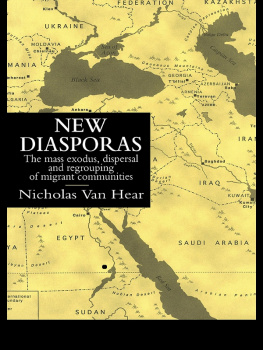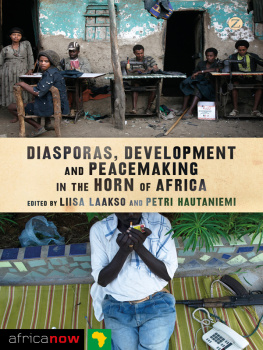
ITALYS MANY DIASPORAS
Italians are a migratory people. Since 1800 over 27 million Italians have left home, but over half have returned to Italy. As cosmopolitans, exiles, and workers of the world they transformed their homeland and many of the foreign countries where they worked or settled.
Drawing on a wide range of studies of Italian migrants to a dozen different countries, Donna Gabaccia puts the modern Italian diaspora in historical context, charting the emergence of this once regionally fragmented diaspora as a nationally conscious cultural group. Italys Many Diasporas provides an ambitious and theoretically innovative overview, examining the social, cultural, and economic integration of Italian migrants. It explores their complex yet distinctive identity and their relationship with their homeland.
Donna R. Gabaccia is Charles H. Stone Professor of American History at the University of North Carolina, Charlotte.
GLOBAL DIASPORAS
Series Editor: Robin Cohen
The assumption that minorities and migrants will demonstrate an exclusive loyalty to the nation-state is now questionable. Scholars of nationalism, international migration and ethnic relations need new conceptual maps and fresh case studies to understand the'growth of complex transnational identities. The old idea of diaspora may provide this framework. Though often conceived in terms of a catastrophic dispersion, widening the notion of diaspora to include trade, imperial, labour and cultural diasporas can provide a more nuanced understanding of the often positive relationships between migrants homelands and their places of work and settlement.
This book forms part of an ambitious and interlinked series of volumes trying to capture the new relationships between home and abroad. Historians, political scientists, sociologists and anthropologists from a number of countries have collaborated on this forward-looking project. The series includes two books which provide the defining, comparative and synoptic aspects of diasporas. Further titles focus on particular communities, both traditionally recognized diasporas and those newer claimants who define their collective experiences and aspirations in terms of a diasporic identity.
This series is associated with the Transnational Communities Programme at the University of Oxford funded by the UKs Economic and Social Research Council.
Already published:
GLOBAL DIASPORAS: AN INTRODUCTION
Robin Cohen
NEW DIASPORAS
Nicholas Van Hear
THE SIKH DIASPORA
Darshan Singh Tatla
ITALYS MANY DIASPORAS
Donna R. Gabaccia
First published in 2000 in the UK
by UCL Press
Reprinted 2003 by Routledge
2 Park Square, Milton Park,
Abingdon, Oxon, OX14 4RN
Transferred to Digital Printing 2005
Routledge is an imprint of the
Taylor & Francis Group
Donna R. Gabaccia
Typeset in Garamond by BC Typesetting, Bristol
All rights reserved. No part of this book may be reprinted or reproduced or utilized in any form or by any electronic, mechanical, or other means, now known or hereafter invented, including photocopying and recording, or in any information storage or retrieval system, without permission in writing from the publishers.
British Library Cataloguing in Publication Data
A catalogue record for this book is available from the British Library
ISBN 1-85728-582-4 (hbk)
ISBN 1-85728-583-2 (pbk)
In memory of my father, Remo Palmo Gabaccia, 192697, and commemorating the centennial of the fatti di maggio, Milan, 1898
CONTENTS
Origins of migrants from Italy, 12001975
Destinations of migrants from Italy, 12001975
Females among migrants from Italy, 12001975
Selected destinations of migrants from Italy, 12001790
Elite migrants who returned to Italy, 12001790
Social class composition of Risorgimento and other European nationalist movements
Destinations of Italys migrants, 17891871
Destinations of migrants by class, 18761914
Annual rates of emigration by region, 18761914
Destinations of migrants by region, 18761914
Females among migrants by region, 18761925
Migrations from Italy, 191345
Destinations of Italys migrants, 191545
Destinations of mobile Italians, 195581
Over the last few years and even since this series was launched in 1997, the expression diaspora has diffused into general social scientific discourse. This has revived old meanings and developed new understandings of the migration experience in cultural studies, history, geography, sociology, and politics. But, just as in the catwalks of Milan and Paris, fashion is no certain guide to utility or to ultimate acceptance. As more and more scholars use the notion of diaspora we have rapidly to learn what are its strengths and limitations.
In this respect Donna Gabaccia is an informed and helpful skeptic. I have provided a fuller definition and discussion of diasporas in the introductory book to this series (R. Cohen, Global Diasporas: An Introduction, 1997) but, in brief, diasporas are partly about the scattering of people. Certainly, many millions of people left Italy perhaps 2 million in the period 17901870 and over 26 million thereafter, when the newly founded Italian state started counting. However, calling them Italians was problematic as no single nationhood existed. This leads to the authors first rupture with the classic diasporic tradition. Regional, city, and village identities remained powerful among Italian migrants, so it seems sensible to talk, as Gabaccia does, of diasporas in the plural, rather than assume there is a single Italian people that dispersed to many places.
The migration from Italy was also generally voluntary, though the force of adverse economic circumstances should always qualify that term. Unlike the classic victim diasporas (the Jews, Armenians, and Africans providing the paradigmatic cases), most migrants from Italy left in pursuit of trade or work. This is, however, no particular bar to understanding them as members of a diaspora or several diasporas, as the victim tradition was too narrow a formula. Diasporas are also about continuing connections with home. And we can and should understand home metaphorically as well as literally. There is a trite saying that captures this point. Home, it is said, is where the heart is and perhaps we should add where the head is and also (given the global adoption of Italian food) where the taste buds are.
The continuation of circulatory migration, of Italian and sub-Italian identities, of the Italian language abroad as well as the development of Little Italies in several countries shows that the cultural and affective elements of a diasporic condition were highly developed among Italys migrants. The sharing of Italianate Catholicism and the occupational niches colonized by many workers of Italian origins also enhanced solidarities. What Gabaccia calls the rebellious poor of Italy filled the global labor market with stonecutters, masons, weavers, spinners, waiters, machine operators, and many other occupations besides. The specificity of their employment, the experience of migration and remigration and their continued cultural distinctiveness meant that Italians constantly shuttled between their cosmopolitan, national, and local experiences. They were often prominent members of the labor movements in their countries of settlement and perhaps just as often organized among their own kind exclusively. Gabaccias book provides a major contribution to understanding the dynamics of working-class organization among those of Italian origins.









